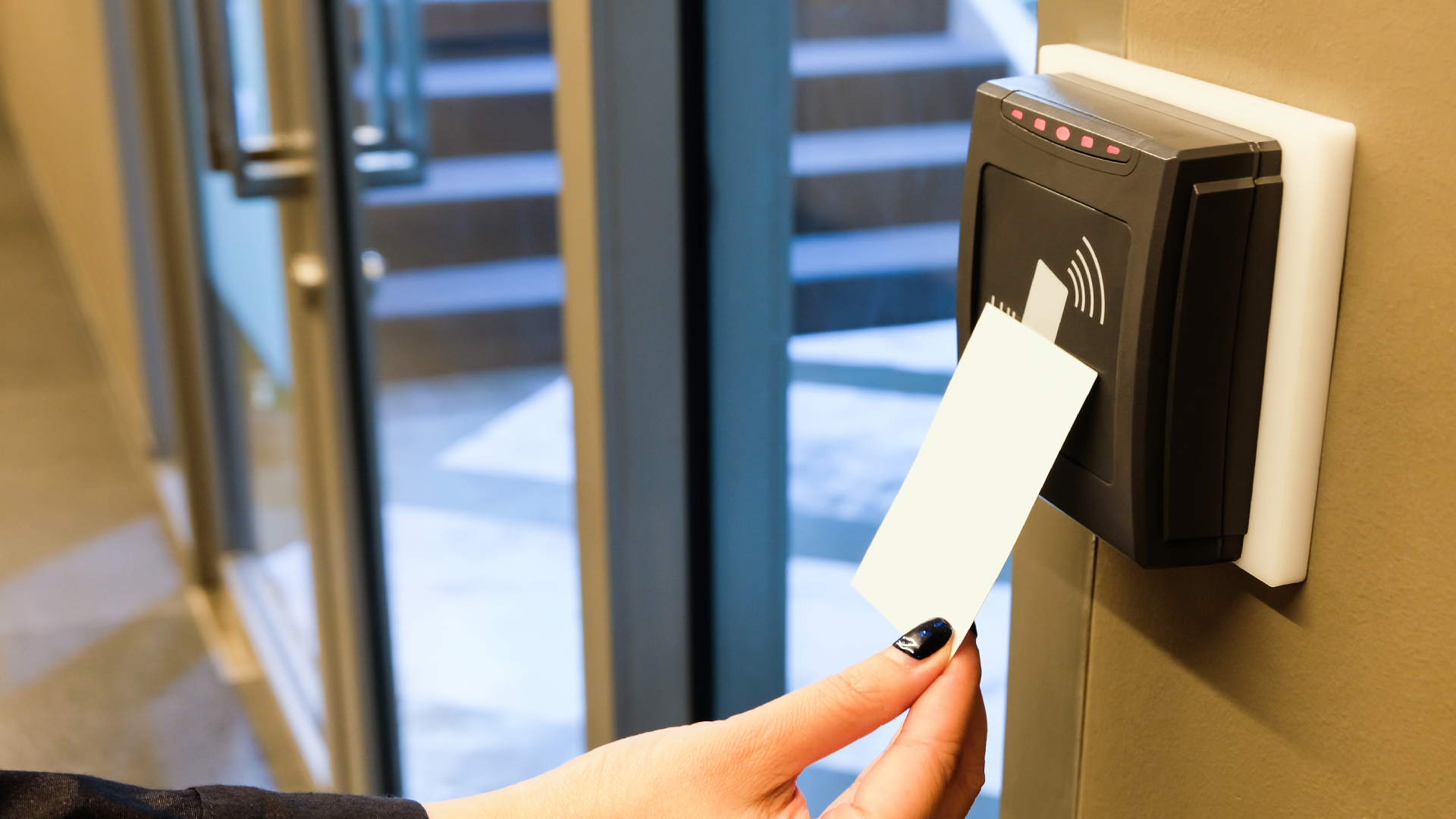
Understanding Access Control Systems: RFID vs. NFC
Access control systems give business owners and managers the power to control what areas employees and other people can access, depending upon each person’s credentials. Just like there are many different brands and types of access control systems, there are also different ways these systems communicate to grant access.
For non-biometric access control systems, doors unlock using Radio Frequency Identification (RFID) or Near Field Communication (NFC) technology. To the casual observer, these are indistinguishable from one another: you hold a card, fob, or object with an RFID or NFC tag embedded in it near a sensor, which reads the tag and determines whether you’re authorized to enter or not.
However, there are differences between these two options. RFID is an older technology and is still widely used in access control systems today. NFC is a refined version of RFID and is growing in popularity due to improvements in its security features.
RFID is a wireless technology that transmits data between devices in one direction.
Access control systems consist of 4 elements: the tag, tag reader, access control panel, and lock.
How does it work? RFID-based access control systems come with physical key cards or key fobs. These are commonly known as tags, and each tag has a unique identification. The system manager can configure the access settings for each tag and then assign them to employees and visitors.
The data for each tag is stored in the tag itself—the trick is to transfer that data from the tag to the tag reader, where RFID comes into play.
Say you are an employee at a retail store. You were assigned a key card when you first started working. This card permits you access to the back storage room. When you want to enter this room, you put your card to the reader on the door and seconds later it unlocks. Success!
What only takes a few seconds is, in fact, a complex process. When an individual places their tag against the tag reader, the tag reader emits a radio wave. This radio wave energizes the tag, providing the power the tag needs to operate. Once powered up, the tag transmits a string of unique identifying data—an encrypted key code—to the tag reader. The tag reader decodes the data and then sends the key code to the access control panel. The access control panel then unlocks the door if the code matches the code already stored in the system. If it does not match, the door remains locked.
RFID systems communicate in one direction: data flows from the tag to the tag reader and then to the access control panel.
Are there any drawbacks? RFID technology has been around for decades, but that does not mean the technology is perfect. Because RFID has been around so long, we are now well aware of its limitations and potential vulnerabilities.
RFID systems are prone to electromagnetic interference. Interference happens when other magnetic devices are nearby or multiple tags are in the same location (a tag reader may attempt to read multiple tags at once, causing issues). If someone really wants to, they can create interference intentionally to jam the tag reader or even disable the entire system.
Someone can also use a transponder device to clone tags. This is easily done, in part because the tag’s unique data never changes and a tag reader can’t tell the difference between a copy and an original.
The technology for copying RFID tags is simple and inexpensive. Anyone can purchase RFID copiers for less than $15 from online retailers. If someone has a copier and physical access to an RFID card or fob, they can copy it in moments.
NFC is a wireless technology that transmits data between devices in two directions.
The main difference between RFID and NFC is that NFC enables two-way communication.
How does it work? NFC transmits data between devices with electromagnetic radio waves. NFC-based access control systems also consist of tags, a tag reader, and an access control panel. NFC tags include key cards, key fobs, and smartphones.
An NFC access control system operates similarly to an RFID system, at least in the physical sense. Present your tag to the reader, and if permitted access, the door will unlock in a few seconds.
However, a lot more is going on within the data transfer process. That’s because data flows in two directions. The tag, tag reader, and access control panel can communicate back and forth to verify authenticity.
The key here is that, in theory, bidirectional data transfer makes access control systems more secure. NFC tags generate one-time use codes. The data transferred from the tag to the tag reader is encrypted, just like RFID systems—but the data is also random and used only once. This makes it much more difficult to clone a tag!
The other big deal here is that you can use smartphones instead of physical cards or fobs. This takes convenience to the next level and can also save money on the cost of cards and fobs.
Are there any drawbacks? The fact is, NFC is a more secure form of access control. It was developed to improve upon RFID, and to this point, it has done just that.
Perhaps the only real drawback is that NFC is newer so it’s not as widely adopted and tested. It can also be a little pricier. RFID is tried and true, despite its known faults. The security industry is rapidly adopting NFC, helped by the fact that many existing RFID systems are compatible with NFC.
What is better for access control, RFID or NFC? There is no one correct answer.
RFID- and NFC-based access control systems both provide the same type of security but in different ways. If you want to know what platform is best for your business, it depends on your specific needs. NFC is more secure in some respects, but it can also be more expensive.
Talk with a local security provider to learn what system is best for your business. They can take into account your needs and priorities and help you build out a system that works for you.
If you are interested in access control, contact Bay Alarm! We are here to help with all your security-related needs. Get in touch with us today for a free system estimate.
Start a conversation with a Bay Alarm security expert.
By submitting this form, you agree to receive marketing emails from Bay Alarm. You can unsubscribe at any time.

